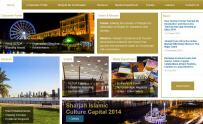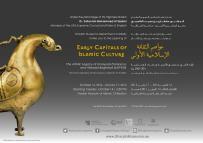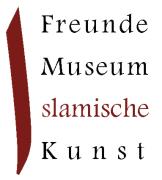Fragen und Antworten
Questions from the National – Berlin Exhibition
Questions for Manal Ataya
1) What is the goal behind this exhibition?
The aim of this exhibition is to make a historical and intellectual link between Sharjah as Capital of Islamic Culture 2014 and two of its earliest predecessors, Umayyad Damascus and Abbasid Baghdad. Indeed, with regard to the vision of its leaders, the extensive and inspired building programs, the patronage of art, culture and the sciences and the active encouragement of intercultural tolerance and dialogue, there are many aspects that Sharjah shares with historical capitals of Islamic culture throughout history.
2) what is its relevance to the UAE and then to the Arab world in general?
This is a unique opportunity to see rare artefacts and archaeological finds charting the very first centuries of Islamic rule. Part of the permanent collections of the Berlin Museum of Islamic Art, these historically and culturally outstanding objects give fascinating insights into the gradual material transition from the pre-Islamic civilizations of the Byzantine and Sasanian worlds to that of a new Islamic culture. At the same time, they are given the opportunity to learn about the life of the Umayyad and Abbasid caliphs in their castles and palaces, be it in the badiyeh of what is now Syria and Jordan or Samarra, one of their temporary capitals in Iraq.
Questions for Dr Ulrike Khamis
3) tell me a little bit more about the exhibition itself. What will it have, what can the visitor expect?
This ground-breaking exhibition focuses on the very first Capitals of Islamic Culture in the history of the Islamic world, i.e. Damascus and Baghdad. The over 100 objects from the Berlin Museum of Islamic Art will provide visitors with an unprecedented and deep insight into one of the most fascinating periods of human history, when a new Islamic culture and artistic traditions were born from the heritage of late Antiquity. Finds relating to pre-Islamic, Umayyad and Abbasid capitals, palace cities and palace complexes include rare items from the former Sasanid capital and early Islamic provincial capital Ctesiphon in Iraq (5th–7th century), the Umayyad “Desert Castles” Khirbet al-Minya (705–15), Qusayr Amra (~730s), the famous Mshatta castle (~744) and the gigantic, temporary capital of the Abbasids - Samarra (9th century), north of Baghdad.
4) Explain to me the three most important pieces coming to the exhibition, their stories and histories.
1: Rosette from the Palace of Mshatta – a monumental flower from the very beginning of Islamic Art
The Umayyad palace of Mshatta is situated approximately 30 km south of Amman (Jordan), built by al-Walid II (ruled 125–126 A.H. / 743–44 C.E.). Inside the Palace of Mshatta, the entrance façade to the official part with the throne hall was adorned elaborated stone carvings, with strongly protruding rosettes in the centre. In the exhibition, one of these exceptional pieces will be shown in a fascinating mirror setting that evokes the entire façade around it.
The Berlin Museum of Islamic Art is very fortunate in that it was gifted a large section of the Mshatta façade (33 m) in the course of the construction of the Hijaz Railway at the beginning of the 20thcentury, a personal gift from the Ottoman Sultan Abdul Hamid II to the German Kaiser Wilhelm II.
2: Aquamanile in the Form of a Bird – an exceptional metal vessel from the time of Harun al-Rashid
This bird-shaped vessel, possibly meant to represent an eagle, is one of the outstanding and rare examples of its kind. It was originally used as a water vessel (aquamanile) and dates into the reign of the Abbasid caliph Harun al-Rashid (170 - 193 A.H. / 786 - 809 C.E.). According to medieval Islamic sources, the Abbasid court used elegant and lavish vessels like this and even ate from gold and silver plates encrusted with gems. None of those or the often quoted lavish silver trees with singing birds in its branches have survived. This artefact therefore gives us a rare insight into the luxurious appearance of Abbasid palace furnishings and implements.
3: Luxurious Tray with Architectural Décor – a core piece of brass work of the Umayyad Period
This exceedingly rare and richly ornamented tray raises many questions. The centre shows a domed building with a kind of column in the centre. A double wing of Persian provenance marks the building as of outstanding significance. The floral decor and the radial architectural arcades are also of Iranian origin, and previous scholars often interpreted the building as a temple. However, interestingly, similar vegetal motifs can also be found in the Dome of the Rock, built in 72 A.H. / 691–692 C.E. Moreover, Umayyad coins of that same year show a similar column to the one on the tray, perhaps a symbol of the qibla, the Islamic direction of prayer. Consequently, this tray may possibly show the Dome of the Rock, the column referring to its location, Jerusalem, as the first qibla.
5) How many related to Syria, and how many to Iraq.
Most of the over 100 objects come from the Syrian Region (Bilad al-Sham), with 24 large items of architectural decoration from the famous temporary Abbasid capital of Samarra.
6) What is the oldest piece coming.....its details...
The oldest pieces are pre-Islamic inscription stones. They originate from the period before Arabic as we know it today developed properly and became the language of the Quran. The Arabic script developed from the Nabataean script in the 1st century A. H./ 7th century C. E. With the spread of Islam, Arabic and its script were disseminated far and wide. Due to its close link to God’s revelations, the Qur’an, Arabic also became a central element of Islamic Art.
7) Given the current state of affairs in Syria and Iraq, what is the importance of such pieces? as well as such exhibitions?
The cultural heritage of Islam is under enormous threat due to war, looting, elicit art trade and deliberate destruction. One important objective of this exhibition is to communicate the importance of this heritage to our audiences, raise awareness and sensitise them. Furthermore, the exhibition shows impressively how deeply Islamic art and culture are rooted in the age-old heritage of this region on the one hand and how they are intricately linked to world history through the ages.
8) What was the common themes during those Islamic periods, Ummayad vs Abbasid. what was distinct in each period from the artistic point of view?
The overarching similarities are probably best sought in terms of vision and patronage. Rulers at the time acted proactively and with progressive vision within their newly conquered lands. They worked with experts, administrators, scientists, scholars, architects, artists and craftsmen from a wide range of cultural and religious backgrounds, chosen simply on the basis of their outstanding skill and experience. Their contributions – hand in hand with the new Islamic faith and power - allowed the Islamic world to establish itself ever more successfully on its ancient foundations and prosper. Here again, the vision of the earliest Islamic leaders seems to foreshadow that of leaders in the UAE today.
9) Please feel free to add what I may have neglected to ask …
Questions for Director Berlin Museum of Islamic Art, Professor Dr Stefan Weber
GD only in the press conference
10) Is this the first collaboration between a Middle Eastern Museum and Museum of Islamic Art in Berlin?
This is our second exhibition in Sharjah, a result of our excellent relations with the Emirate since 2008, when we presented ‘The Radiance of Islamic Art’ to celebrate the opening of the Sharjah Museum of Islamic Civilization. In 2014, we are extremely proud to be part of Sharjah’s celebrations as Capital of Islamic Culture, and we would like to seize the opportunity to congratulate Sharjah for its outstanding contributions to art, culture and education. Given our ever deepening professional and scholarly connections withSharjah in 2012, Berlin Museums, together with the German Goethe Institute, joined hands with the Sharjah Museums Department to sign a far-reaching and comprehensive Memorandum of Understanding aimed at museological cooperation. The exhibition ‘Early Capitals of Islamic Culture’ is a direct outcome of this alliance.
The MoU with Sharjah is the latest in Berlin’s long history of cooperation with Muslim countries. In fact it has been more than 110 years that scholars from the city first went to excavate in the Arab-Islamic world and undertook the first ever excavation on an Islamic site in 1911. Other aspects of collaboration since then have included professional training, joint restoration projects like the recent restoration of the Mschatta Palace or indeed institutional cooperations, like the remaking of the National Museum in Herat or the Haram al-Sharif Museum in Jerusalem.
11) How did it come about? What is the purpose of it?
As a German museum with archaeological and artistic material from the Islamic world, we see it as only natural to work with the countries from which the material originally came to us in Berlin. I see it as one of our key objectives to be in constant cooperation with Muslim countries – but for me, it is even more than that – my commitment represents a very personal love and interest: I myself lived 12 years in Syria and Lebanon and I am married to a Syrian.
12) Tell me about your Museum, how large the Islamic collection and will there be other future exhibitions in the UAE from Berlin’s museum?
The Berlin Museum of Islamic Art was founded in 1904. It is located within the Pergamonmuseum in Berlin. The Islamic Museum is the only institution of its kind in Germany, the second oldest in the world after the Cairo Islamic Museum and with its ca 50.000 objects one of the major collections of Islamic Art. From the beginning, the concept of showing trans-regional connections in its setup was innovative. Last year, the Museum of Islamic Art counted 900.000 visitors, making it the key institution for cultural education in its field. In 2020, the museum will move to another location within the Pergamonmuseum – the most visited museum in Berlin - and will vastly expand its exhibition space to about 3.000 square meters. Due to the nature of our collections, the early Islamic period is particularly important to us as it has always featured prominently in excavations, research, restoration and presentation since the founding of the museum.
Interviewquelle: Doro Riemenschneider 2014
Kaléidoscope cre-aktiv | Archivsite 2013 - 2017 | NEU seit 2017: www.cre-aktive.net





